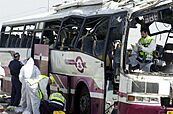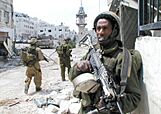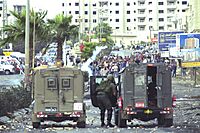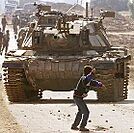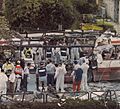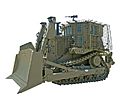Second Intifada facts for kids
Quick facts for kids Second Intifada |
|||||||||
|---|---|---|---|---|---|---|---|---|---|
| Part of the Israeli–Palestinian conflict | |||||||||
|
Clockwise from top-left:
|
|||||||||
|
|||||||||
| Belligerents | |||||||||
| Commanders and leaders | |||||||||
|
|
||||||||
| Units involved | |||||||||
|
|
||||||||
| Casualties and losses | |||||||||
|
29 September 2000 – 1 January 2005: ~1,010 Israelis total:• 644–773 Israeli civilians killed by Palestinians; • 215–301 Israeli troops killed by Palestinians |
29 September 2000 – 1 January 2005: 3,179–3,354 Palestinians total:• 2,739–3,168 Palestinians killed by Israeli troops;* • 152–406 Palestinians killed by Palestinians; • 34 Palestinians killed by Israeli civilians |
||||||||
| 55 foreign nationals/citizens total: • 45 foreigners killed by Palestinians; • 10 foreigners killed by Israeli troops |
|||||||||
| *For the controversial issue of distinguishing Palestinian civilian/combatant casualties, see § Casualties. | |||||||||
The Second Intifada (also called the Al-Aqsa Intifada) was a major uprising by Palestinians against the Israeli occupation. It was a time of increased violence in the Palestinian territories and Israel from 2000 to 2005.
Many believe the uprising started because peace talks at the 2000 Camp David Summit failed in July 2000. Violence increased in September 2000 after Israeli politician Ariel Sharon visited the Al-Aqsa compound in East Jerusalem. This visit was peaceful, but it led to protests and riots. Israeli police used rubber bullets, live ammunition, and tear gas to stop them.
During this time, many people were hurt or killed, including both civilians and fighters. A key difference from the First Intifada (1987-1993) was the use of suicide bombings by Palestinians, which often targeted Israeli civilians. Overall, about 3,000 Palestinians, 1,000 Israelis, and 64 foreign nationals died.
The Sharm el-Sheikh Summit in 2005 is often seen as the end of the uprising. At this meeting, Palestinian president Mahmoud Abbas and Israeli prime minister Ariel Sharon agreed to stop the fighting. Palestinian groups would stop violence against Israelis, and Israel would stop military actions against Palestinians. They also agreed to follow a "roadmap for peace" plan. Sharon also agreed to release some Palestinian prisoners and withdraw Israeli troops from parts of the West Bank.
Contents
What is the Second Intifada?
The term Second Intifada means a second Palestinian uprising. It followed the First Intifada, which happened between 1987 and 1993. The word "Intifada" (انتفاضة) comes from an Arabic word meaning "the shaking off." It refers to a revolt against the Israeli presence in the Palestinian territories.
The name Al-Aqsa Intifada comes from Al-Aqsa, a mosque compound in the Old City of Jerusalem. This area is sacred to both Muslims and Jews.
Some Israelis call it the Oslo War or Arafat's War. They believe it resulted from agreements made after the Oslo Accords. Others think the strong response to early protests caused the uprising to become a full-scale conflict.
Why Did the Uprising Start?
The Oslo Accords and Peace Efforts
The Oslo Accords were agreements signed in 1993 and 1995. Israel agreed to gradually remove its forces from parts of the Gaza Strip and West Bank. This allowed Palestinians to have self-government in those areas through the Palestinian Authority. The Palestine Liberation Organization (PLO) recognized Israel and agreed to manage security in the areas Israel left.
This self-rule was meant to be a temporary step for five years while a permanent peace agreement was worked out. However, both sides were unhappy with how the Oslo process turned out. Many felt that Palestinian freedom of movement got worse. Over 650 people were killed in the five years after the Oslo agreements.
The Camp David Summit
From July 11 to 25, 2000, a peace summit was held at Camp David in the United States. US President Bill Clinton, Israeli Prime Minister Ehud Barak, and Palestinian Authority Chairman Yasser Arafat attended. The talks did not succeed, and each side blamed the other.
There were five main issues they could not agree on:
- Borders and land connections.
- The status of Jerusalem and the Temple Mount.
- The return of Palestinian refugees.
- Israel's security concerns.
- Israeli settlements.
After the summit failed, many Palestinian groups became frustrated. Some Fatah groups even joined Hamas and Islamic Jihad.
Israeli Settlements
After the Oslo Accords, there was continued building in existing Israeli settlements. This caused strong criticism from Palestinian leaders. Even though building within existing settlements was allowed by the Oslo agreements, many Palestinians felt it went against the spirit of peace. They believed it made it harder to reach a final agreement.
The Spark: Ariel Sharon's Visit
The Second Intifada began on September 28, 2000. This was after Ariel Sharon, who was running to become Israel's Prime Minister, visited the Temple Mount. This area, also known as Al-Haram Al-Sharif, is very important to both Jews and Muslims. Sharon was joined by over 1,000 security guards. He said that day, "the Temple Mount is in our hands and will remain in our hands."
Palestinians saw this visit as very upsetting. Protesters threw stones at police and were met with tear gas and rubber bullets from the Israeli Army. A riot started, leading to clashes between Israeli forces and the crowd. Some believe the Intifada truly began the next day, September 29, when more clashes and deaths occurred.
How the Conflict Was Fought
Palestinian Actions
Unlike the First Intifada, which mostly involved protests and strikes, the Second Intifada quickly became an armed conflict. Palestinian groups fought against the Israel Defense Forces. Palestinian tactics included:
- Suicide bombings, often targeting Israeli civilians.
- Launching rockets and mortars into Israel.
- Kidnapping soldiers and civilians.
Israeli Actions
Israeli tactics aimed to limit Palestinian movements. They set up checkpoints and enforced strict curfews in some areas. Israel also attacked Palestinian Authority buildings like police stations and prisons. This was done to pressure the Palestinian Authority to stop anti-Israeli protests and attacks.
Global Involvement
Many countries and groups have been involved in the Israeli–Palestinian conflict. This involvement grew during the Al-Aqsa Intifada. Israel receives a lot of military aid from the United States each year. The Palestinian Authority also receives financial aid from the United States, the Arab League, the European Union, and the World Bank.
Private groups also became involved. The International Solidarity Movement supported Palestinians, while the American Israel Public Affairs Committee supported Israelis. Arab states also pledged support for the Second Intifada.
Effects on Peace Agreements
The Second Intifada changed how Israelis viewed the Oslo Accords. Before the Intifada, in May 2000, about 39% of Israelis supported the Accords. By May 2004, this number dropped to 26%. Fewer people believed the Accords would lead to peace. Later, a survey showed that 80% of Israelis felt the Israel Defense Forces had successfully handled the Intifada militarily.
Economic Impact
Impact on Israel
The Israeli economy was significantly affected. Tourism dropped sharply, causing major financial losses. One estimate put the total economic damage at $35–45 billion.
Impact on Palestinian Authority
The Palestinian economy also suffered greatly. The United Nations estimated the damage to the Palestinian economy at over $1.1 billion in the first three months of 2002. This was a large amount compared to their annual economic output.
Images for kids
-
CIA map of areas governed by the Palestinian Authority, July 2008.
See Also
- First Intifada (1987–1993)
- Taba Summit (2001)
- Sharm el-Sheikh Summit of 2005
- Israeli disengagement from Gaza (2005)
- Israeli West Bank barrier – started in 2002
- Sumud (steadfastness)
- 1990 Temple Mount riots
- Silent Intifada (2014)
- Israeli–Palestinian conflict (2015)
- Palestinian nationalism
- Palestinian territories
- List of modern conflicts in the Middle East


